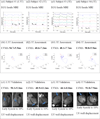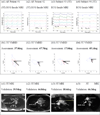Left-ventricular mechanical activation and aortic-arch orientation recovered from magneto-hydrodynamic voltages observed in 12-lead ECGs obtained inside MRIs: a feasibility study
- PMID: 25224074
- PMCID: PMC4241154
- DOI: 10.1007/s10439-014-1109-2
Left-ventricular mechanical activation and aortic-arch orientation recovered from magneto-hydrodynamic voltages observed in 12-lead ECGs obtained inside MRIs: a feasibility study
Abstract
To explore use of the Magnetohydrodynamic Voltage (VMHD), observed in intra-MRI 12-lead electrocardiograms (ECG), to indicate the timing of the onset of left-ventricular mechanical activation (LVMA) and the orientation of the aortic-arch (AAO). Blood flow through the aortic arch during systole, in the presence of the MRI magnetic field (B 0), generates VMHD. Since the magnitude and direction of VMHD are determined by the timing and directionality of blood flow relative to B 0, we hypothesized that clinically useful measures, LVMA and AAO, could be extracted from temporal and vectorial VMHD characteristics. VMHD signals were extracted from 12-lead ECG traces by comparing traces obtained inside and outside the MRI scanner. VMHD was converted into the Vectorcardiogram frame of reference. LVMA was quantified in 1 subject at 1.5T and 3 subjects at 3T, and the result compared to CINE MRI. AAO was inferred for 4 subjects at 3T and compared to anatomical imaging of the aortic arch orientation in the transverse plane. A < 10% error was observed in LVMA measurements, while a < 3° error was observed in aortic arch orientation measurements. The temporal and vectorial nature of VMHD is useful in estimating these clinically relevant parameters.
Figures




Similar articles
-
Continuous Rapid Quantification of Stroke Volume Using Magnetohydrodynamic Voltages in 3T Magnetic Resonance Imaging.Circ Cardiovasc Imaging. 2015 Dec;8(12):10.1161/CIRCIMAGING.115.003282 e003282. doi: 10.1161/CIRCIMAGING.115.003282. Circ Cardiovasc Imaging. 2015. PMID: 26628581 Free PMC article.
-
Exploring magnetohydrodynamic voltage distributions in the human body: Preliminary results.PLoS One. 2019 Mar 6;14(3):e0213235. doi: 10.1371/journal.pone.0213235. eCollection 2019. PLoS One. 2019. PMID: 30840694 Free PMC article.
-
3DQRS: a method to obtain reliable QRS complex detection within high field MRI using 12-lead electrocardiogram traces.Magn Reson Med. 2014 Apr;71(4):1374-80. doi: 10.1002/mrm.25078. Epub 2014 Jan 22. Magn Reson Med. 2014. PMID: 24453116 Free PMC article.
-
A 1.5T MRI-conditional 12-lead electrocardiogram for MRI and intra-MR intervention.Magn Reson Med. 2014 Mar;71(3):1336-47. doi: 10.1002/mrm.24744. Magn Reson Med. 2014. PMID: 23580148 Free PMC article.
-
[MR-based tridirectional flow imaging. Acquisition and 3D analysis of flows in the thoracic aorta].Radiologe. 2007 Nov;47(11):1012-20. doi: 10.1007/s00117-007-1577-6. Radiologe. 2007. PMID: 17932640 Review. German.
Cited by
-
Continuous Rapid Quantification of Stroke Volume Using Magnetohydrodynamic Voltages in 3T Magnetic Resonance Imaging.Circ Cardiovasc Imaging. 2015 Dec;8(12):10.1161/CIRCIMAGING.115.003282 e003282. doi: 10.1161/CIRCIMAGING.115.003282. Circ Cardiovasc Imaging. 2015. PMID: 26628581 Free PMC article.
-
Exploring magnetohydrodynamic voltage distributions in the human body: Preliminary results.PLoS One. 2019 Mar 6;14(3):e0213235. doi: 10.1371/journal.pone.0213235. eCollection 2019. PLoS One. 2019. PMID: 30840694 Free PMC article.
-
The Magnetohydrodynamic Effect and its Associated Material Designs for Biomedical Applications: A State-of-the-Art Review.Adv Funct Mater. 2016 Jun 14;26(22):3942-3952. doi: 10.1002/adfm.201504198. Epub 2016 Feb 24. Adv Funct Mater. 2016. PMID: 29527149 Free PMC article.
References
-
- Gupta A, Weeks AR, Richie SM. Simulation of elevated T-waves of an ECG inside a static magnetic field (MRI) IEEE transactions on bio-medical engineering. 2008;55:1890–1896. - PubMed
-
- Blandford R, Thorne K. Applications of Classical Physics. CA: CalTech; 2004. Magnetohydrodynamics.
-
- Krug J, Rose G. Magnetohydrodynamic distortions of the ECG in different MR scanner configurations. Computing in Cardiology. 2011:769–772.
-
- Birkholz T, Schmid M, Nimsky C, Schuttler J, Schmitz B. ECG artifacts during intraoperative high-field MRI scanning. Journal of neurosurgical anesthesiology. 2004;16:271–276. - PubMed
-
- Nijm G, Swiryn S, Larson A, Sahakian A. Characterization of the magnetohydrodynamic effect as a signal from the surface electrocardiogram during cardiac magnetic resonance imaging. IEEE; 2006.
Publication types
MeSH terms
Grants and funding
LinkOut - more resources
Full Text Sources
Other Literature Sources

